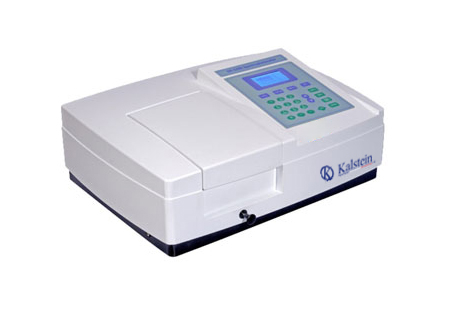In the quest for accurate and reliable spectrophotometry, two products stand out in the market: the UV VIS Spectrophotometer with Ultraviolet-Visible Scanning Software- YR01857 by Kalstein and the Cary 60 UV-Vis Spectrophotometer by Agilent. Each product promises precision, technological advancement, and user convenience, but subtle differences set them apart, influencing the choice of consumers based on specific needs and applications.
The Kalstein YR01857 is a blend of modern design and advanced technology. It features ultraviolet-visible scanning software, which enhances its ability to deliver precise measurements across a broad spectrum range. The integration of advanced software allows for comprehensive data analysis, catering to a variety of scientific and industrial applications. Meanwhile, Agilent’s Cary 60 offers notable features with its robust design and high throughput. Renowned for its speed and efficiency, the Cary 60 has become a preferred choice in settings where high sample analysis rates are required.
| Feature | Kalstein YR01857 | Agilent Cary 60 |
|---|---|---|
| Spectral Range | 190-1100 nm | 190-1100 nm |
| Software | Ultraviolet-Visible Scanning Software | Advanced Data Analysis Tools |
| Scanning Speed | Optimized for precision | Fast; ideal for high throughput |
| Usability | User-friendly interface | Efficient for experienced users |
| Price Range | Competitive pricing | Premium |
How They Work
The Kalstein YR01857 operates by passing ultraviolet and visible light through its scanning system, analyzing the wavelengths absorbed by the sample. Its advanced software simplifies data processing, ensuring precise readings even with complex mixtures. The Cary 60, powered by Agilent technology, is engineered for rapid measurements, featuring a Xenon flash lamp that maximizes performance, particularly beneficial for samples requiring swift throughput.
What is it For
The Kalstein UV VIS Spectrophotometer with Ultraviolet-Visible Scanning Software- YR01857 is essential for laboratories requiring accurate spectroscopic analysis. It serves industries ranging from pharmaceuticals to environmental science, providing detailed assessments of compound purity, concentration, and quality. It’s also instrumental in academic research, enabling breakthroughs through accurate data collection.
Types
UV-Vis spectrophotometers, such as the ones offered by Kalstein and Agilent, are generally categorized based on their wavelength range, scanning capabilities, and software integration. They may be designed for use in general laboratories or specialized applications, requiring models that can handle specific samples or throughput needs.
Price Range
In the market, spectrophotometers range widely in price based on their features and capabilities. Typically, the Kalstein YR01857 is competitively priced, making it an attractive option without compromising on essential functionalities. In contrast, Agilent’s Cary 60 may fall on the higher end of the price spectrum, reflecting its premium build and specialized applications.
Frequently Asked Questions
What are the primary uses of UV-Vis spectrophotometers?
UV-Vis spectrophotometers are used to measure how much a chemical substance absorbs light by measuring the intensity of light as a beam passes through the sample solution.
How do I choose between the Kalstein YR01857 and Agilent Cary 60?
Your choice should depend on your specific application needs, budget, and throughput requirements. The Kalstein YR01857 offers precise scanning capabilities at a competitive price, while the Agilent Cary 60 is optimized for high-throughput applications.
Can these spectrophotometers be used for environmental testing?
Yes, both models are capable of conducting environmental testing, which often requires precise measurement of harmful substances in water and air samples.
Are there significant differences in software capabilities?
While both products offer advanced software, Kalstein’s software is particularly noted for its user-friendly interface, which may benefit users who prioritize ease of use alongside detailed analysis.
Advantages and Disadvantages
The Kalstein YR01857 stands out for its integration of cutting-edge software, competitive pricing, and flexibility across various applications, making it a versatile choice for many labs. Conversely, the Cary 60’s strength lies in its high-speed throughput, ideal for environments demanding rapid results. However, this might come at a premium cost and a steeper learning curve.
Field Use of the Product
In practical applications, both spectrophotometers excel in delivering reliable results. The Kalstein model is particularly valued in educational settings for its affordability and ease of use, encouraging student engagement and learning. Industrial labs favor the Cary 60 for its efficiency in high-demand conditions, where analysis speed is crucial.
Recommendations
For optimal performance, it is recommended to regularly calibrate your spectrophotometer and conduct routine maintenance checks. Proper training on the software enhances precision and effectiveness, allowing you to maximize the full potential of your investment. Consider logging detailed records of usage to preemptively identify potential issues and prolong the lifespan of your equipment.
If you’re searching for a fusion of innovation and quality, you’ve come to the right place. At Kalstein, we offer you the luxury of exploring our exclusive catalog of laboratory equipment. We manufacture each piece with excellence. Our online purchase channels are intuitive and agile, designed for your convenience, ensuring the most friendly prices. Don’t hesitate any longer; we bring science to life; it’s time to be part of our community. https://kalstein.cn/product/uv-vis-spectrophotometer-with-ultraviolet-visible-scanning-software-yr01857/.

